
PATIENCE IS REQUIRED Making halva involves lots of stirring. |
I went to a gathering of thirty Azerbaijani-Americans in a home near the Portland Jetport to learn how to make halva. It's a confection served in various forms in the Middle East, parts of Asia, Africa, and Europe. Sometimes it's made with pistachios and sesame paste, but in Azerbaijan, the caramel-like sweet is made out of butter, flour, water, sugar, salt, and a little turmeric.
Afet Nadirova, a middle-aged woman with black hair pulled back into small ponytail, was my teacher. She melted three sticks of butter in a large skillet and then mixed in enough flour to make the texture of peanut butter cookie dough. She kept pressing sections of this flour-and-butter dough with her spoon into the pan on medium-low heat, preventing the mixture from burning and continuing to enmesh the butter and the flour. "How long do you have to do that?" I asked. When she responded, "An hour," I thought we might be up against a language barrier. She meant it. As Afet and I took turns stirring, her friend Zemfira made sugar-syrup by heating up sugar and water together in a small soup pot.
After forty minutes of stirring and mashing, the dry dough seemed to give up, and become its new form: a wet paste that left the swirling marks of Afet's constantly moving wooden spoon. She added a pinch of salt and half a teaspoon of turmeric, and continued stirring. Over time the mixture turned from light tan to dark caramel, at which point Afet mixed in the simple syrup. What resulted was a full pan of thick caramel. Afet spooned this onto salad plates, tilting them slightly this way and that way to encourage the halva to spread evenly. Lastly, Afet imprinted the cooling halva on each plate with the tip of her spoon, again and again, making a decorative pattern on the surface.
The reason Afet and her friend were making halva for these guests was to commemorate the loss of a village where Azerbaijani people used to live twenty years before. What happened to this village in Azerbaijan on February 25 and 26, 1992, is still disputed between Armenia and Azerbaijan.
From the perspective of the Azerbaijani-Americans gathered, this is what happened: There was a village named Khojaly, home to 2500 rural mountain people, Azerbaijanis, or Azeris as they are called, living peacefully. Armenian and Russian forces surrounded this village in secret and massacred many of its inhabitants, including women, children, and elders, and grossly disfigured the dead bodies.
The grief of those gathered in Portland felt similar to that of Americans on an anniversary of 9/11. Part of their grief is that whatever organization or person ordered the attacks has not claimed responsibility, or been held to account. To commemorate the lives of those lost, guests ate a potluck feast of foods from the village's region: a giant platter of yellow rice, Cornish hen with egg, beef with apricots, yogurt soup, Cornish hen stuffed with ground walnuts and pomegranate molasses, and pickled and fresh garden vegetables. After the feast, Afet and her friend served the plates of halva, with Earl Grey tea steeped with cardamom, lemon slices, blackberries, grapes, homemade pastries, and an additional box of Dunkin' Donuts.
For recipes from the feast, including halva, and to contact the author visit ImmigrantKitchens.com.